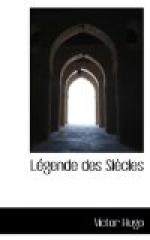les douze pairs. The twelve Paladins of tradition, who formed Charlemagne’s Round Table.
L. 6-10. These words are taken almost verbatim from Jubinal’s adaptation of the story in the Musee des Familles. Jubinal’s words are:
’L’etcheco-sauna (le laboureur des montagnes) est rentre chez lui avec son chien; il a embrasse sa femme et ses enfants. Il a nettoye ses fleches ainsi que sa corne de boeuf, et les ossements des heros qui ne sont plus blanchissent deja pour l’eternite.’
In a note Jubinal says: ’Ces paroles sont empruntees au chant basque d’Altabicar.’
Son cheval syrien. In the Chanson Charlemagne rides on a mulet de Sulie (Syrie). Jubinal changed the mule into a horse. This is one of the points of detail which show that Hugo followed the modern author.
L. 25. The city, as we learn subsequently, was Narbonne. Narbonne is on the west coast of the Gulf of Lyons, near the eastern end of the Pyrenees. Originally a Roman colony, it was one of the chief seats of the Visigoths, from whom it was taken by the Saracens, when they overran Southern France. Charlemagne took it from the latter in 759. Till the fourteenth century it was a port, but the sand has blocked up the harbour and the town is now some distance from the sea.
machicoulis, battlements; or, more exactly, a gallery round the tower with openings in it from which projectiles could be hurled upon an enemy below.
vermeil. The word is one of Hugo’s favourite adjectives, and is used to suggest a bright vivid red, and almost invariably in connexion with objects that have pleasurable associations.
The following are a few typical instances of its use:—
‘L’aube vermeille.’ (Les Feuilles d’Automne: Madame, autour de vous.)
‘Les cones vermeils’ (du palais dans les nuages). (Ibid.: Soleils Couchants.)
‘Les beaux rosiers vermeils.’ (Les Quatre Vents: L’Immense Etre.)
‘Les astres vermeils.’ (Ibid.: La Nuit.)
‘Aux soirs d’ete qu’embrase une clarte vermeille.’ (Dieu L’Ange.)
’Les plats bordes de fleurs sont en vermeil: (Eviradnus.)
’Et, vermeille,
Mahaud, en meme temps que l’aurore, s’eveille.’ (Ibid.)
The word seems to be used without any definite suggestion of colour in such phrases as ‘des espaces vermeils’ (Plein Ciel), ’quand le satyre fut sur la cime vermeille’ (Le Satyre), ’des arbres vermeils’ (of trees lit up by the setting sun) (Le Crapaud).
The word is used with a bold extension of meaning in Les Voix Interieures: A Eugene, where the appetite of boyhood is called ‘l’appetit vermeil.’
dromon, mediaeval warship, worked by oars and sail, the ancestor of the galley. The word is also used, as apparently here, for merchantmen.




